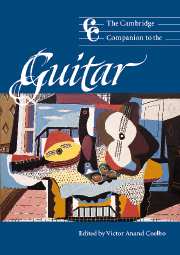Book contents
- Frontmatter
- Part I New guitar histories and world traditions
- 1 Picking through cultures: a guitarist's music history
- 2 Flamenco guitar: history, style, status
- 3 The Celtic guitar: crossing cultural boundaries in the twentieth century
- 4 African reinventions of the guitar
- Part II Jazz, roots, and rock
- Part III Baroque and classical guitar today
- Glossary
- Notes
- Select bibliography
- General index
- Index of song and album titles
2 - Flamenco guitar: history, style, status
from Part I - New guitar histories and world traditions
Published online by Cambridge University Press: 28 September 2011
- Frontmatter
- Part I New guitar histories and world traditions
- 1 Picking through cultures: a guitarist's music history
- 2 Flamenco guitar: history, style, status
- 3 The Celtic guitar: crossing cultural boundaries in the twentieth century
- 4 African reinventions of the guitar
- Part II Jazz, roots, and rock
- Part III Baroque and classical guitar today
- Glossary
- Notes
- Select bibliography
- General index
- Index of song and album titles
Summary
Flamenco guitar constitutes an instrumental idiom of remarkable richness and contemporary vitality. As a musical tradition, its status is unique in that while its origins lie in folk music and its practitioners articulate little in the way of a standardized theory, it embodies a degree of technical virtuosity and sophistication comparable to that of a classical art form. Flamenco can be seen as comprising song (cante), dance (baile), and guitar playing (toque). The status of guitar music within this framework is ambiguous and contradictory. Flamenco, in its origins, basic structure, and traditional aesthetic orientation, is primarily vocal music, to which guitar accompaniment is a secondary (and occasionally even dispensable) addition. Nevertheless, the guitar has come to play an increasingly prominent role in accompaniment, and flamenco solo guitar has emerged as an independent idiom that has achieved greater international renown than vocal flamenco. This essay provides a brief historical and stylistic overview of flamenco guitar, outlining its distinctive features and its unique status within flamenco and world music as a whole.
The evolution of flamenco
The early history of flamenco, like the origin of the word “flamenco” itself, is ultimately obscure. In the past, various Spanish flamencólogos (“flamencologists”) argued that flamenco derived from an ancient and private tradition which the Gypsies brought with them when they migrated from India some six or more centuries ago. Nevertheless, it now seems clear that the genre emerged in the late eighteenth century, primarily from the corpus of Andalusian folk music, especially as stylized and refined by Gypsy professional musicians. Andalusian musical culture was itself an eclectic entity, syncretizing the legacy of the region's diverse ethnic groups (see Plate 3).
- Type
- Chapter
- Information
- The Cambridge Companion to the Guitar , pp. 13 - 32Publisher: Cambridge University PressPrint publication year: 2003



